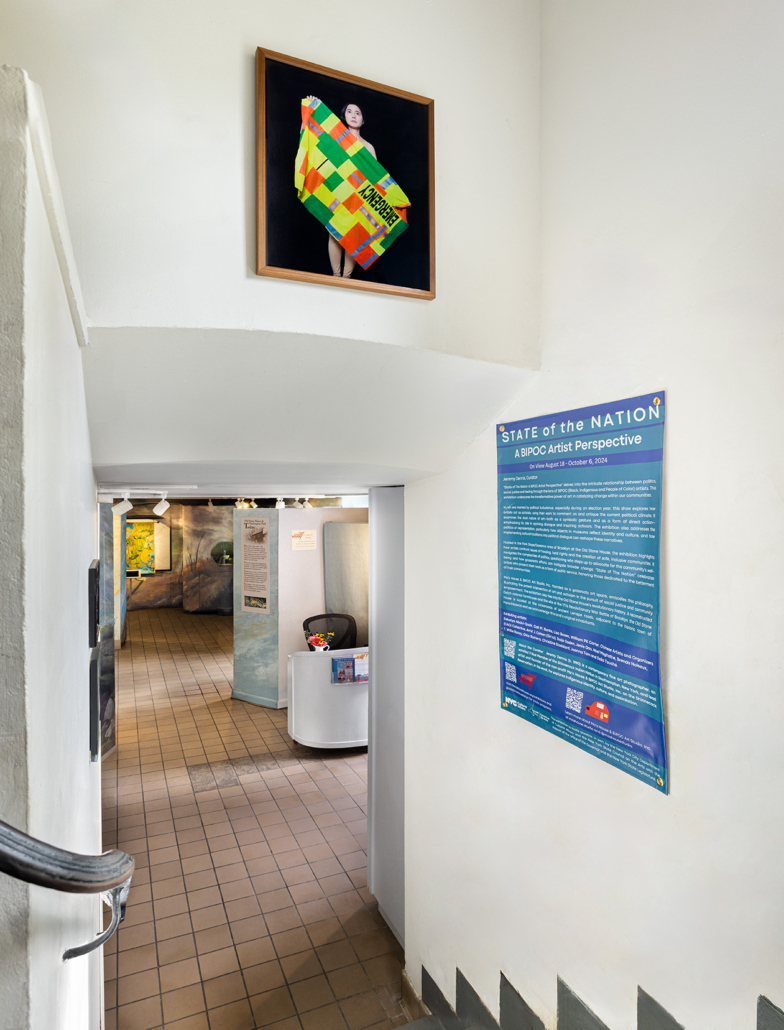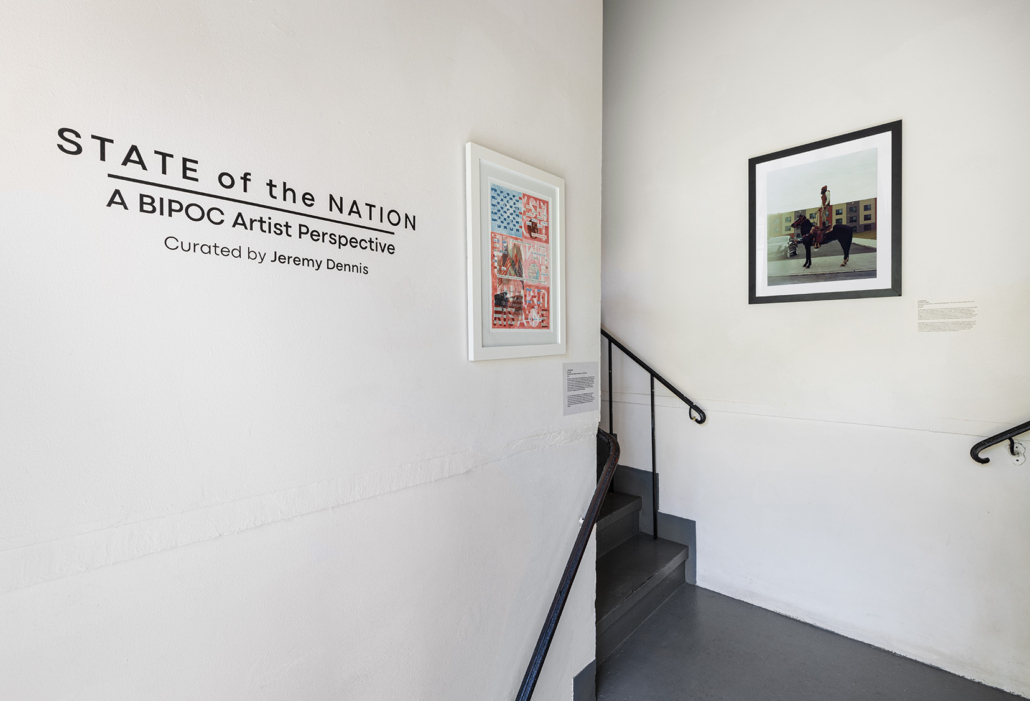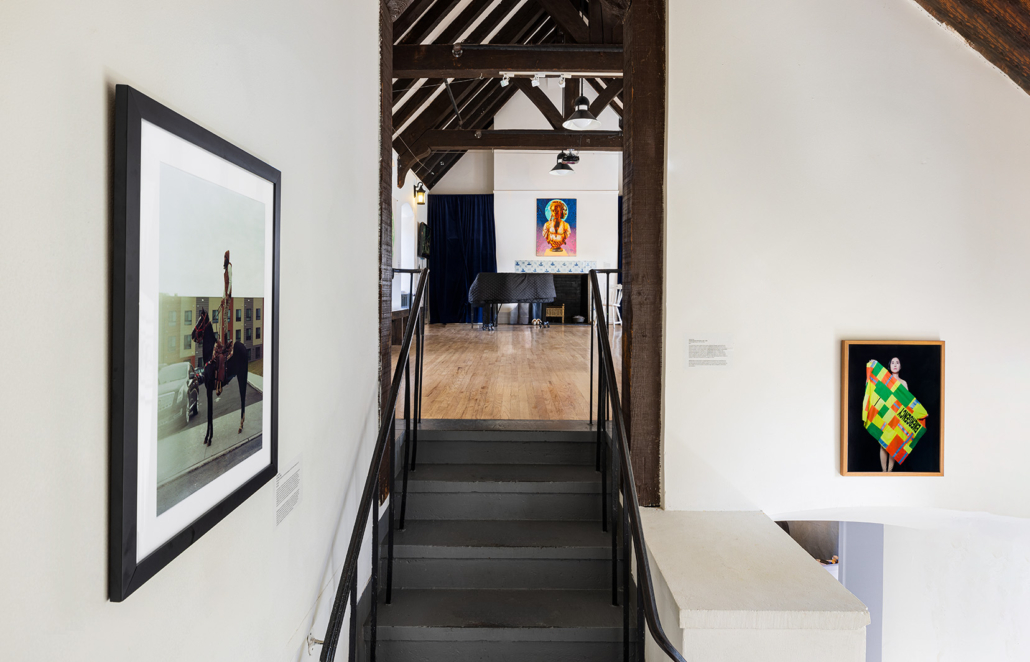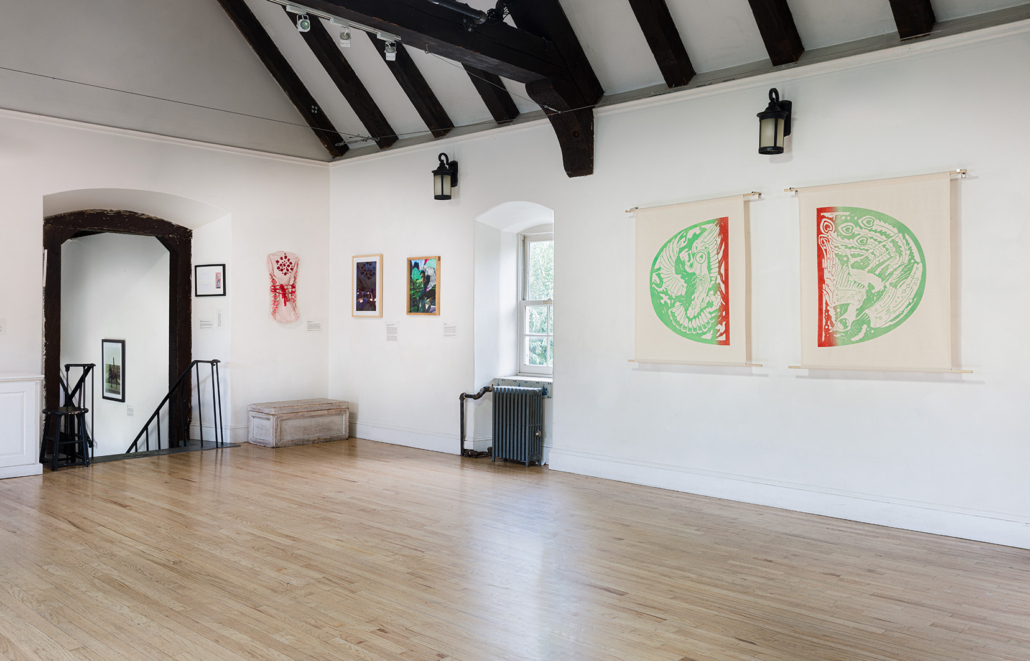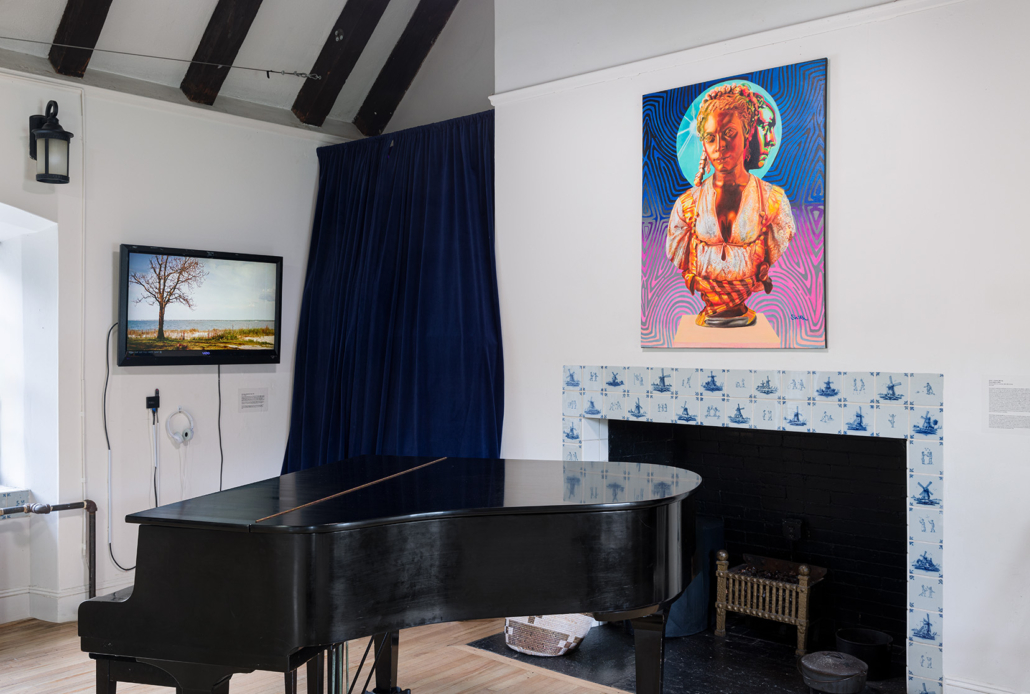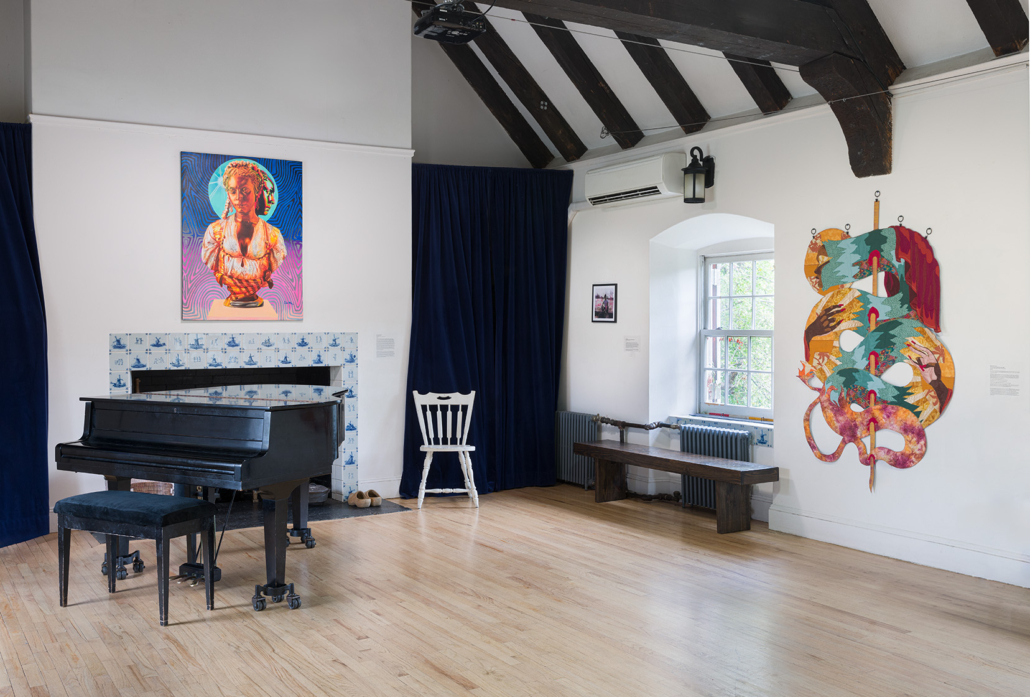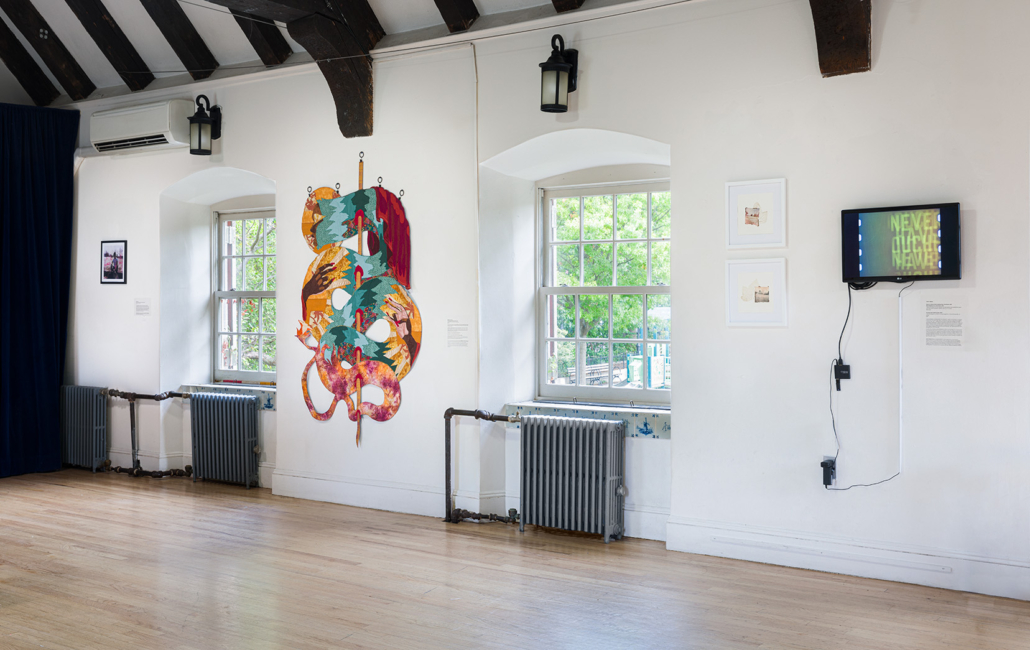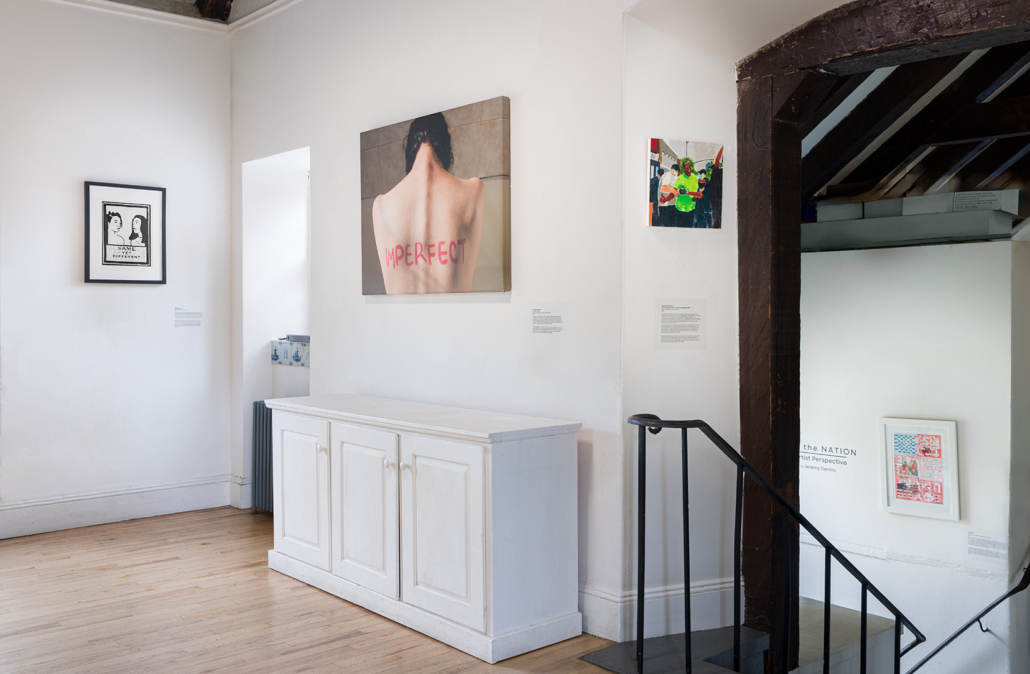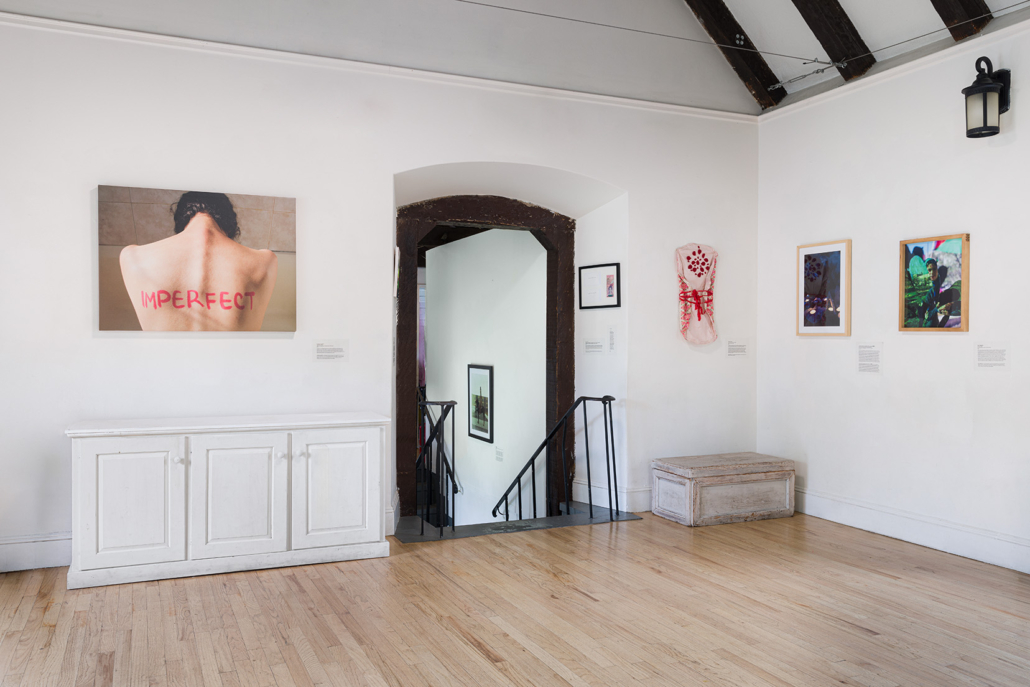State of The Nation: A BIPOC Artist Perspective
Jeremy Dennis, Curator
August 17, 2024 – October 6, 2024
Opening Reception: August 18th, 2024, 4:00 – 6:00 pm
Gallery Hours: Friday – Sunday, Noon – 4 pm
“State of The Nation: A BIPOC Artist Perspective” delves into the intricate relationship between politics, social justice, and healing through the lens of BIPOC (Black, Indigenous, and People of Color) artists. This exhibition underscores the transformative power of art in catalyzing change within our communities.
In an era marked by political turbulence, especially during an election year, this show explores how artists act as activists, using their work to comment on and critique the current political climate. It examines the dual nature of art—both as a symbolic gesture and as a form of direct action—emphasizing its role in sparking dialogue and inspiring activism. The exhibition also addresses the politics of representation, particularly how objects in museums reflect identity and culture, and how implementing cultural traditions into political dialogue can reshape these narratives.
Hosted in the Park Slope/Gowanus area of Brooklyn at the Old Stone House (OSH), the exhibition highlights how artists confront issues of housing, land rights, and the creation of safe, inclusive communities. It navigates the complexities of politics, questioning who steps up to advocate for the community’s well-being and how grassroots efforts can instigate broader change. “State of The Nation” celebrates artists who present their work as a form of public service, honoring those dedicated to the betterment of their communities.
Ma’s House & BIPOC Art Studio, Inc., founded as a grassroots art space, embodies this philosophy, illustrating the potent intersection of art and activism in the pursuit of social justice and community empowerment. The exhibition also ties into OSH’s revolutionary history. A reconstructed Dutch colonial farmhouse and the site of the 1776 Revolutionary War Battle of Brooklyn, OSH is also at the crossroads of ancient Lenape roads, adjacent to the historic town of Marechkawick, and we acknowledge this land’s original inhabitants.
About the Curator
Jeremy Dennis (b. 1990) is a contemporary fine art photographer, an enrolled Tribal Member of the Shinnecock Indian Nation in Southampton, NY, and lead artist and founder of the non-profit Ma’s House & BIPOC Art Studio, Inc. on the Shinnecock Reservation. In his work, he explores Indigenous identity, culture, and assimilation.
Participating Artists:
Chinese Artists and Organizers (CAO) Collective 离离草
Enjoy this virtual tour slide show of the exhibition, photographed by Etienne Frossard.
Public Programs:
Sunday, September 29, 2024, 12:00 – 2:00 PM: State of the Nation Gallery Artist Talk
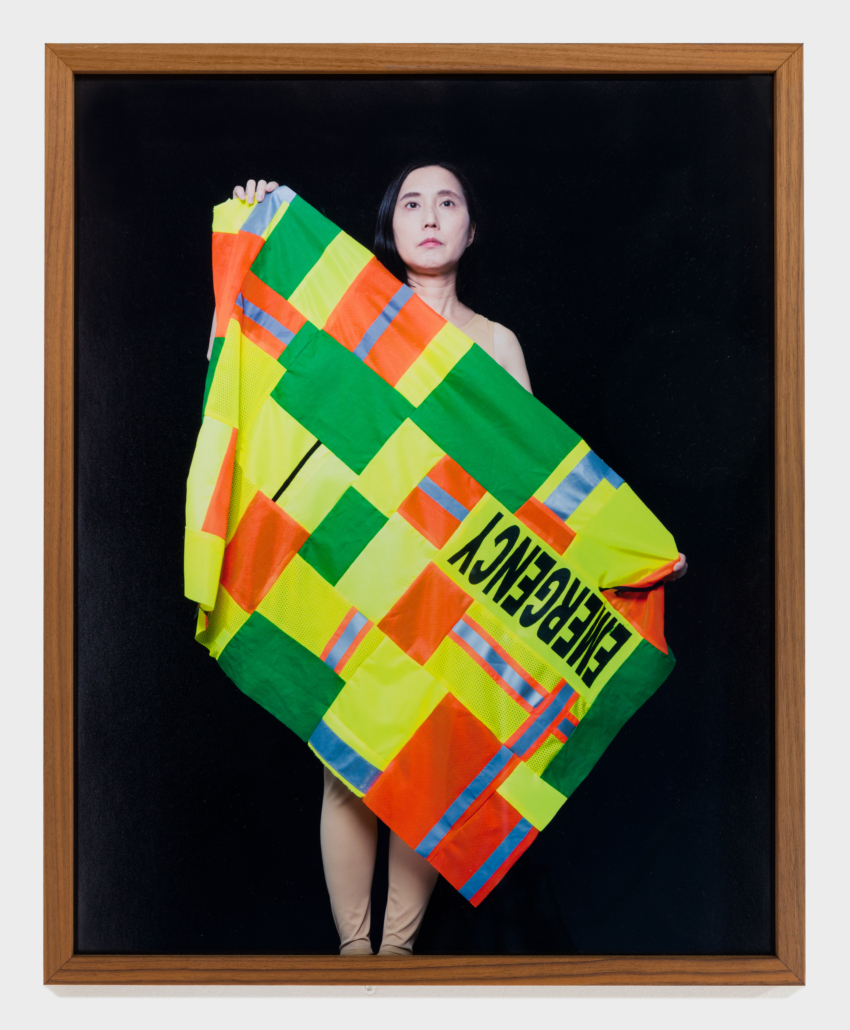
Joanna Tam
Visibility Blanket (Portrait) #1, 2021 – 2022
Archival pigment print, 20 x 16 inches
$650
My current body of work unpacks the complex connection between hypervisibility and invisibility in relation to safety for folx whose identities do not align with societal norms. While it is crucial to increase the visibility of people who have not been seen historically, it is not that simple. To some, being visible in public spaces could put them in danger due to systemic oppression and inequalities. For the State of the Nation exhibition, I am presenting a photographic work from my Visibility Studies project. In Visibility Blanket (Portrait), I take pictures of myself interacting and performing with my Visibility Blanket, which is made from used safety vests (to represent hypervisibility and safety) and green screen material (to represent invisibility). This photo uses self-empowerment to respond to injustice. It also draws our attention to the urgency to resist.
Joanna Tam is a Hong Kong-born visual artist who lives and works on the ancestral and unceded lands of the Wampanoag and the Massachusett People, also known as Boston. Her interdisciplinary practice examines migration, the construction of national identity, the idea of safety and one’s connection to places through video, photography, performance and installation. Her work has been exhibited nationally and internationally. Recent solo exhibitions include American Studies 2019 at the Center for American Political Studies at Harvard University; Visibility Studies at Regis College Fine Arts Center, MA; Wasenstraße Story at Chrom VI in Idar-Oberstein, Germany; Standard Practice at Carol Schlosberg Gallery at Montserrat College of Art, MA; and American Studies at the Teaching Gallery at Hudson Valley Community College, NY. Tam’s projects have been awarded Best Art Film at the Aesthetica Short Film Festival in York, UK, and the Third Prize at the Prix de la Photographie, Paris. She is also the recipient of the 2020 SMFA Traveling Fellowship. She has been invited to attend artist residencies at the Center for Photography at Woodstock, the Boston Center for the Arts, the Boston Children’s Museum, the Vermont Studio Center, and the Wedding Cake House. Her work has appeared in The Boston Globe, the Boston Art Review, Artscope, and Emergency Index. Tam holds an MFA from the School of Museum of Fine Arts at Tufts University.
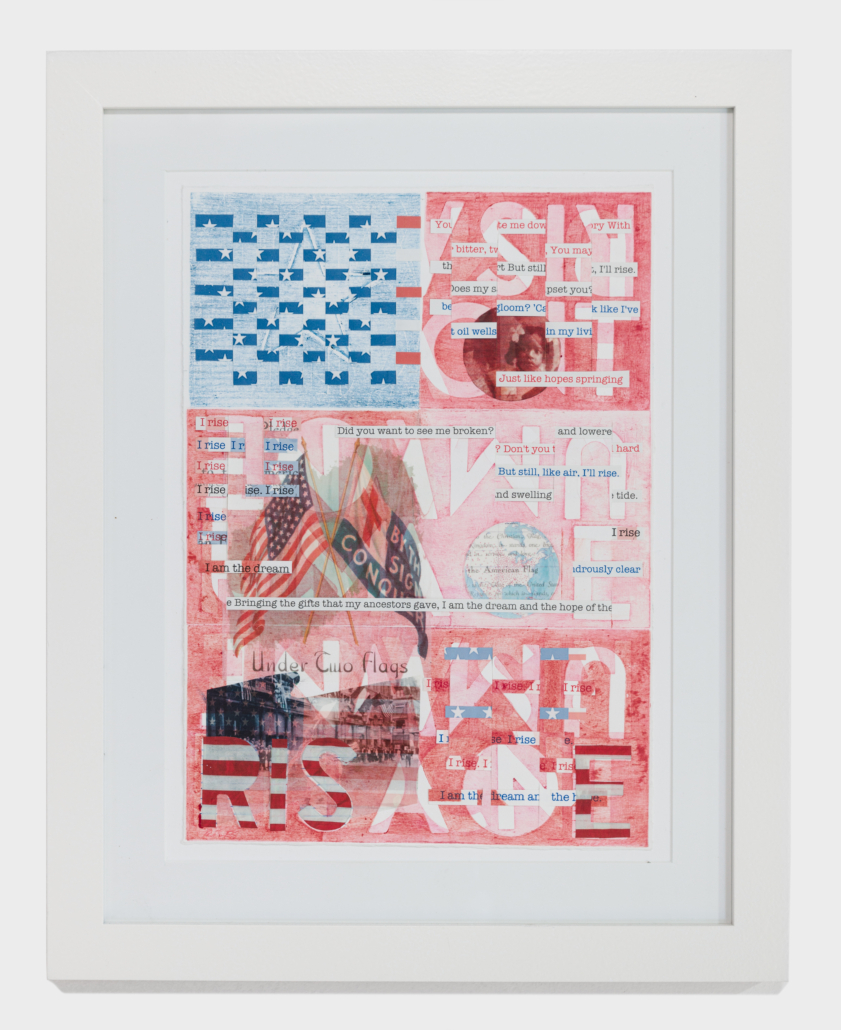
T. Willie Raney
Rise, 2021
Collagraph with Collage and Ephemera, 16 x 20 inches
$525
Rise features woven lines of text from Maya Angelou’s Still I Rise. I created this work a year before the nomination of Supreme Court Justice Ketanji Brown Jackson. An image of one of my mother’s sisters at a young age appears with vintage flag posters. The words “Under Two Flags” refer to the American flag and a Christian flag. It eerily nods to the increase in Christian nationalism in the United States. The words “Under Two Flags” also refer to the uneven conditions by which BIPOC citizens are treated and living in America. At the bottom, the letters R-I-S-E are imprinted with stripes of red and white to circle back to Maya Angelou’s message of the Black American struggle.
Born Thelma Willie Raney in Washington, D.C., Raney received a B.F.A. from Ithaca College in 1979. During the 1980’s and 1990’s, she exhibited in New York City; Port Chester; Silvermine Guild, New Canaan; Norwalk; and Essex, Connecticut. She was invited to participate in two shows featuring the works of African Americans at Lynchburg College, Lynchburg, Virginia, and the Center for Contemporary Printmaking in Norwalk, Connecticut. In 1990, she graduated from Southern Connecticut State University with a Master’s in Art Education and began a career as an art educator in public schools where she has won numerous awards and grants including the 2016 John Rogers Memorial Award for Human and Civil Rights, 2006-2007 CAEA Outstanding Middle Level Art Educator of the Year and the 2005 Robert Rauschenberg Foundation, The Power of Art Grant. Her first solo exhibition was in 1998 at The Gallery at Riverside Press in Essex, Connecticut with a second show at Mercer Corporation in New York City followed by a solo show at the Town and Country Club of Hartford, Connecticut. She joined the artists of Gallery One CT in 2012, an association of mid-career artists whose vision is to provide southeastern Connecticut with a stimulating resource of exhibitions. Her work seeks to create both physical and spiritual balance using influences from objects found in nature, especially those with texture, light and rhythm. She counts Rothko, Boothe, Homer, Richter, Sargent, Beardon, Jackie Saccoccio and Degas as her mentors. Her current work combines printmaking, paint and collage with a focus on layers, text and illumination. “I’m always trying to push the boundaries of underlying structures and how layers can be defined.”
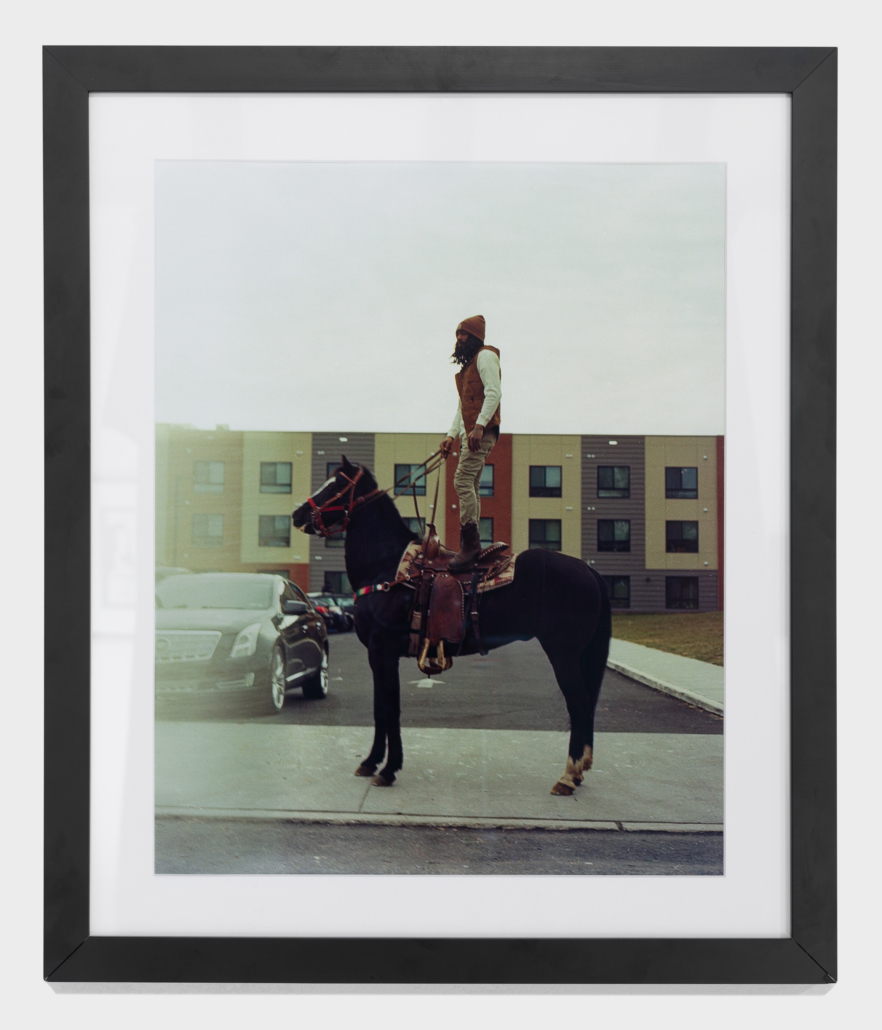
Lisa Brown
Sir Rider, 2024
Analog photography, archival photography, 16 x 20 inches matted (24 x 36 framed)$ $1,000
In the tapestry of American history, the narrative of African American horse riders has often been overlooked, marginalized or erased. Reclamation: Riding the Legacy seeks to spotlight and celebrate this vibrant aspect of heritage, casting a light on the resilience, dignity and cultural significance of African Americans within the equestrian world. Each image and detail echoes the spirit of reclamation as we honor the contributions and struggles of African American horse riders throughout history. From the skilled riders of the American West to the equestrian communities of the antebellum South, their stories are woven into the fabric of our shared heritage, demanding recognition and reverence.
Lisa Brown (b. 1984) was raised between Washington, D.C., and Compton, California. Her journey as an artist began early, driven by a deep passion for analog photography and darkroom printing. Drawing inspiration from her grandfather’s captivating street photography, Lisa’s artistic trajectory has been guided by a commitment to capturing the essence of life through her lens. Currently pursuing an MFA in Community Arts at Maryland Institute College of Art, Lisa’s academic path reflects her dedication to integrating art with community engagement through ethnographic cinematography.
Lisa’s work has garnered recognition from esteemed institutions and publications, including the Pittsburgh Art Society, Black Is Magazine, and Dayton Art Institute. Her accomplishments underscore the resonance and impact of her art within both local and broader artistic circles.
In her pursuit of artistic excellence, Lisa is supported by fellowships and mentorship programs, most notably under the guidance of Titus Brooks Heagins. These opportunities not only provide her with valuable resources and connections but also empower her to navigate the complexities of the art world while nurturing her artistic practice.
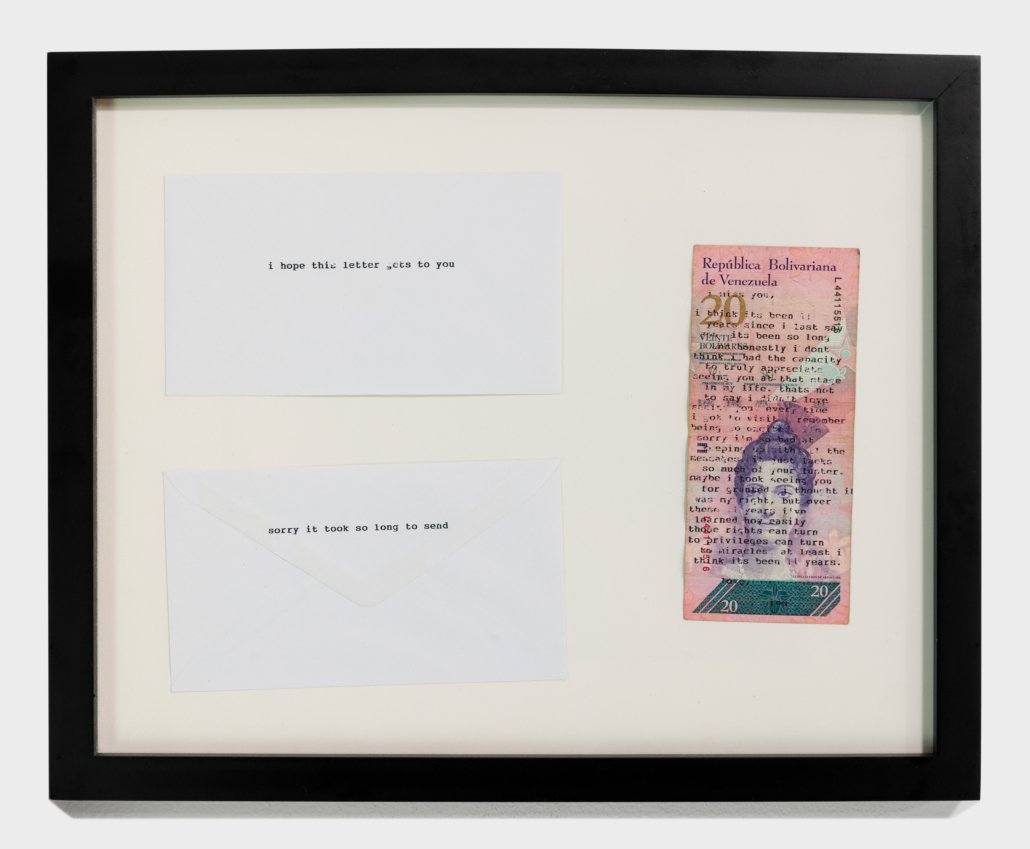
gino romero
I hope this letter gets to you (sorry it took so long to send), 2023
Typewriter on bolivar and envelope, 3.625 x 6.5 inches
NFS
Due to the humanitarian crisis in Venezuela, 7.7 million Venezuelans have been displaced globally, and more continue to flee the country every day. Many people were denied refuge in the United States because of the immigration laws and have died waiting for aid to be distributed–if it is even accessible. As members of the diaspora, how can we mourn what has been lost as the crisis persists? This work contextualizes that grief within the systems that have caused it.
gino romero (b. 1997 in Miami, Florida) holds an MFA in Fine Arts from Parsons School of Design and a BA in Studio Art from Florida State University. They are an ordained minister, an archivist, an educator, and they consider growing up Queer and Trans in predominantly Latinx spaces as part of their education. Their work has been exhibited nationally at venues, including Phyllis Strauss Gallery, Museum of Fine Arts (Tallahassee), 621 Gallery, Also Gallery, Grace Exhibition Space, SoMad Gallery, Rosekill Art Farm, and Arnold and Sheila Aronson Gallery. Their work is part of the collections at the Art Institute of Chicago, Cornell University, Massachusetts College of Art and Design, University of Southern California (USC), among others.
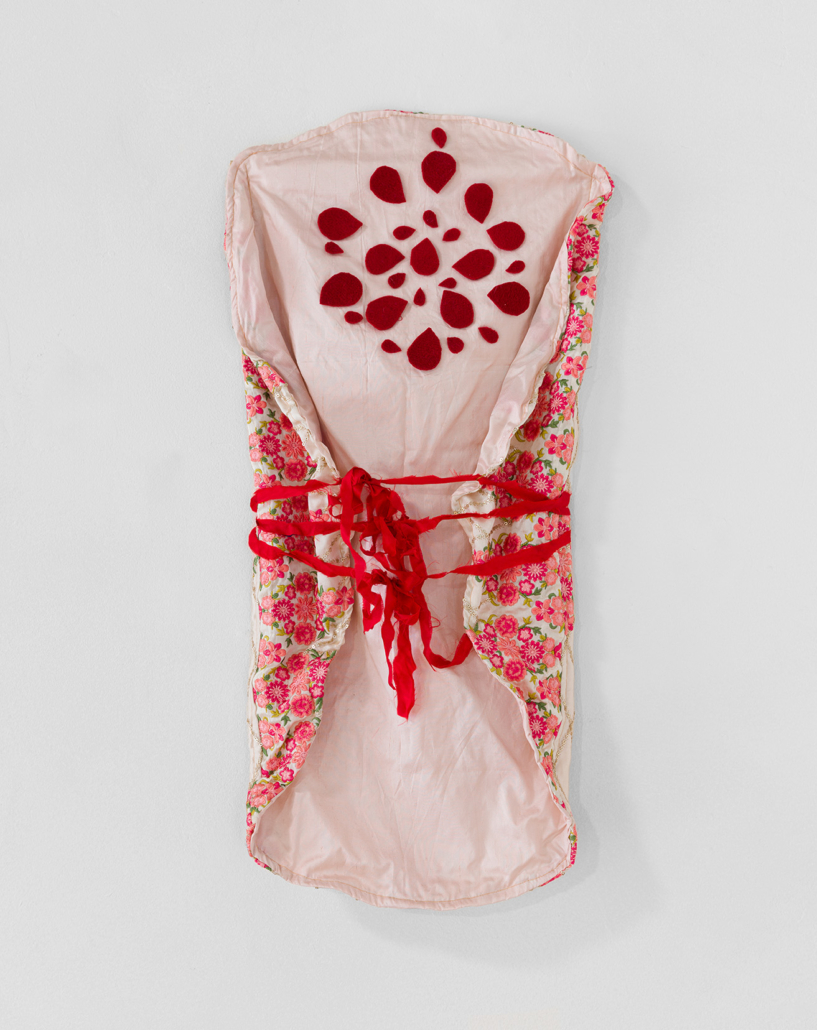
Brenda Noiseux
Period Pad Burial Shroud, 2022
Fiber art, 29 x 25 inches
NFS
I created this work after the fall of Roe v. Wade in 2022, knowing that our country would continue to reduce healthcare for society’s most vulnerable women, putting our very lives at risk. As we continue toward the election in 2024, I wish I felt more optimistic.
The period pad is synonymous with the shame of being a girl, a woman or a womb-bearer – the shame of our biology, the shame of our socio-economic status and the shame of our need for reproductive medical care. As anti-abortion laws across the country increase, it also represents the increased likelihood of our death. The shroud is made of multiple layers of silk and scaled to the size of an American Girl doll. The 26 red wool spots represent the 13 states where abortion is banned and the 13 states where it is highly restricted. The 3 frayed red silk ties represent how women of color have a 2-3 times higher risk of maternal mortality.
Brenda Noiseux is a New Hampshire-based photographer and mixed media artist who believes in making accessible art.
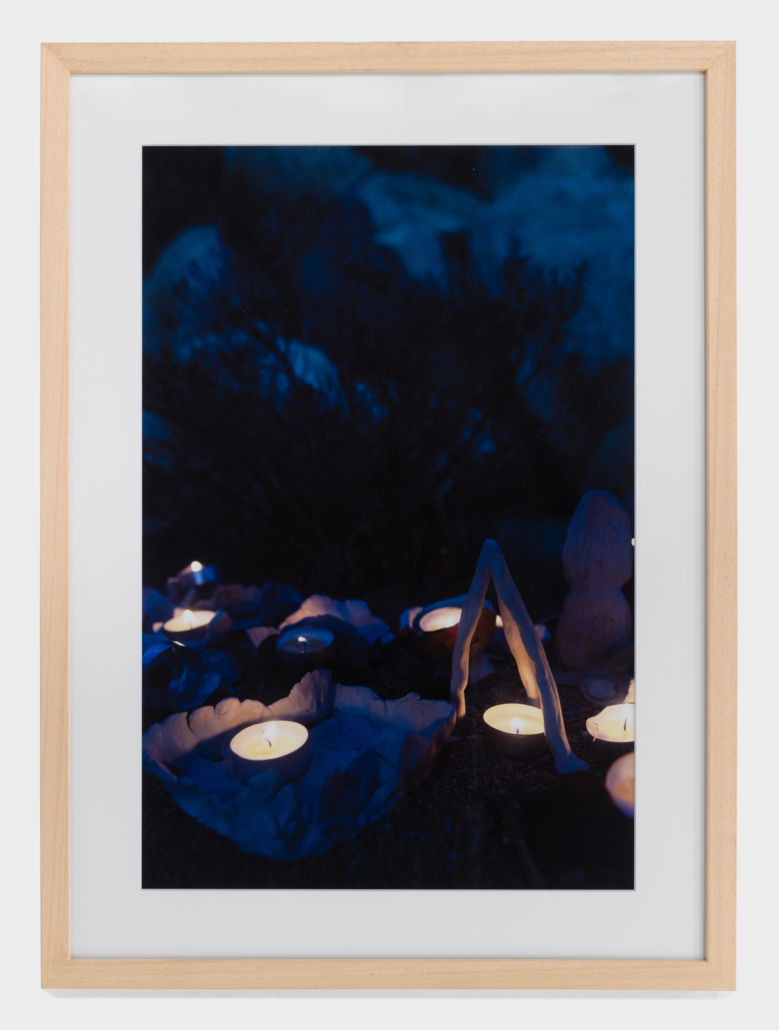
Chinese Artists and Organizers (CAO) Collective 离离草
Memory Funeral (Good Mourning), 2023-2024
Performance, photography, 18-1/4 x 24-3/4 inches
$1,100
Good Mourning结哀顺变 is an annual durational performance in Joshua Tree, California, exploring mourning as a relational act and generative force that reimagines queer/feminist futures of co-living, care and survival. In Winter 2022, confronted with both US-China tensions and mass Covid deaths in both countries, several Chinese queer feminists gathered to process our shared grief as a catalyst for world-building. This photo, Memory Funeral, shows a communal ceremony. Thinking about alternative ways of holding grief and being held by grief, we made candle holders shaped like hands, lotus leaves and dumplings. These holders inevitably crack and leak, similar to our bodies’ responses to incommensurable grief. The candles were left over from White Paper vigils in 2022, but also remind us of celebrations in the transnational Chinese queer feminist community. At 5:30 AM, as the first dawn of 2024 gradually lit up the reserve, we lit candles and read poems we collectively wrote in response to Palestinian and Uyghur poets and our own memories of grief. We blew out the candles and made wishes for the new year. More than mourning for what we have lost, this communal ritual makes space for what is yet to come.
Chinese Artists and Organizers (CAO) Collective 离离草 creates art to empower relational community healing. They make space for nuanced narratives rooted in China, the Sinophone diaspora, and other experiences from the margins. As cultural organizers, they explore social justice-oriented theorizing and narrativizing through communal and processual art practices. Their interdisciplinary praxis interweaves collective poetry, performance, food art, clay, photography, sound, video, children’s games, meditation, herbal medicine, and installation. Their works investigate systems of discipline, control, censorship, and capitalist extraction and reimagine memory/memorials, rituals, intimacy, and queer/feminist kinship to (re)build sustainable community infrastructures. They explore the idea of languaging as a moving and fluid site, a contact zone for improvisation.
CAO Collective is a 2023-24 resident at BRICLab: Contemporary Art cohort and was a collaborator with Laura Li in Pedantic Arts Residency (2024, Pittsburgh, PA) and Feminist Incubator Residency at Project for Empty Space (2022-23, Newark, NJ).
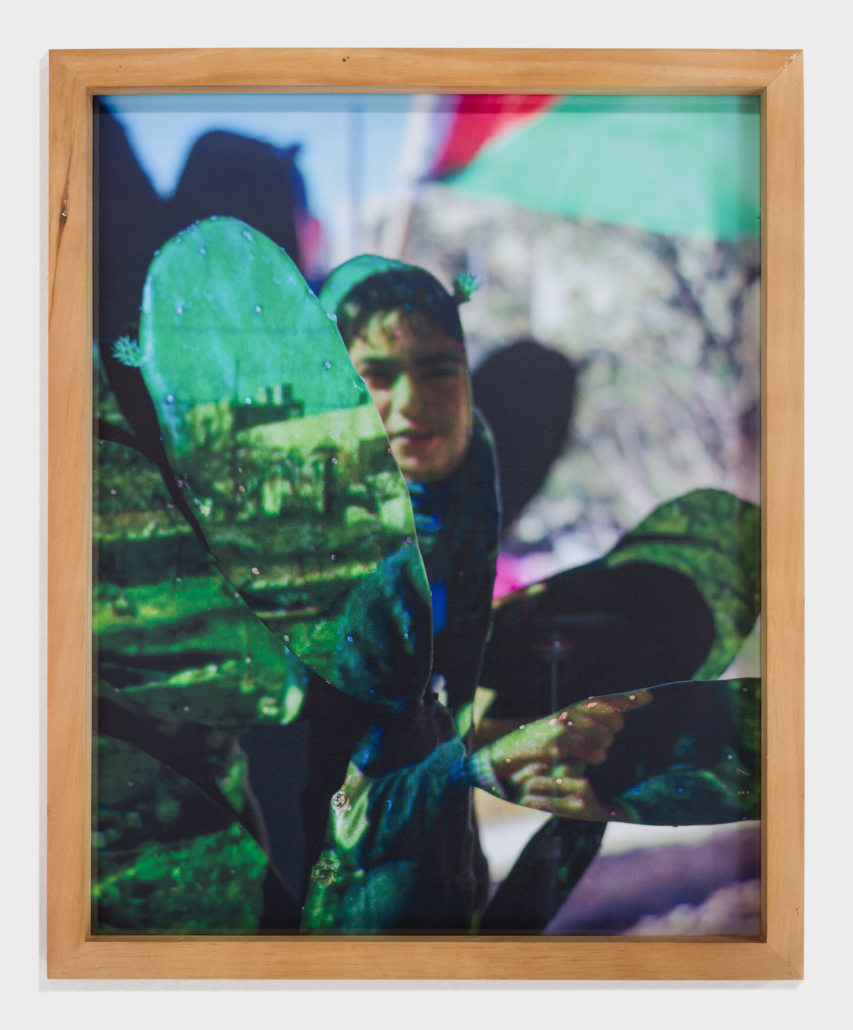
Noel Maghathe
Sumud, 2024
Archival pigment print,16 x 20 inches
NFS
While researching archived photos of my family’s village in Palestine, I found a photograph of a young boy on the website PalestineRemembered.com. This photograph speaks of our steadfast connection to the land, while examining the distortion of diaspora through the image projected on the pads of the cacti reflecting on each piece of the image now fragmented. The username associated with this photo was “فلسطينية وافتخر (Palestinian and Proud)” in 2009. Titled: “حلحول: سيبقى اطفال حلحول يرفع علم بلادهم عاليا شامخا فوق ارضهم “Halhul: The children of Halhul will continue to raise their country’s flag high above their land)”. One comment under the photo reads “انا من حلحول واكبر امنيه نفسي احققها اني اروح لحلحول لو حتى يوم يارررريت لو تتحقق هالامنيه بدور على صور لحلحول وبتحسر مناي ازور بلدي, (I am from Halhul, and my biggest wish that I can fulfill is to go to Halhul, if only for one day. I hope this wish comes true. I look for pictures of Halhul and regret that I [may not?] will visit my country.)” These quotes reflect the longing felt by many in the diaspora for our homeland we cannot reach.
Noel Maghathe is a multi-disciplinary artist and curator based out of Cincinnati, Ohio. Maghathe seeks to create impactful moments of connection in their practice that are deeply rooted in their heritage. Their current works draw inspiration from Palestinian resilience in all forms. Through sculpture, performance, and light, they explore themes of identity, cultural memory, and longing.
They have exhibited and performed both nationally and internationally, including at the Cincinnati Contemporary Arts Center and the Abrons Arts Center in New York, NY, among other spaces, and shared curatorial projects at the Cue Art Foundation in New York, NY, Roots & Culture Contemporary Arts Center in Chicago, IL, and apexart in New York, NY. They have also participated in notable residencies such as Ma’s House & BIPOC Art Studio on the Shinnecock Indian Reservation and with Trocadero Art Space, Melbourne, AU. Maghathe earned a BFA from the Art Academy of Cincinnati.
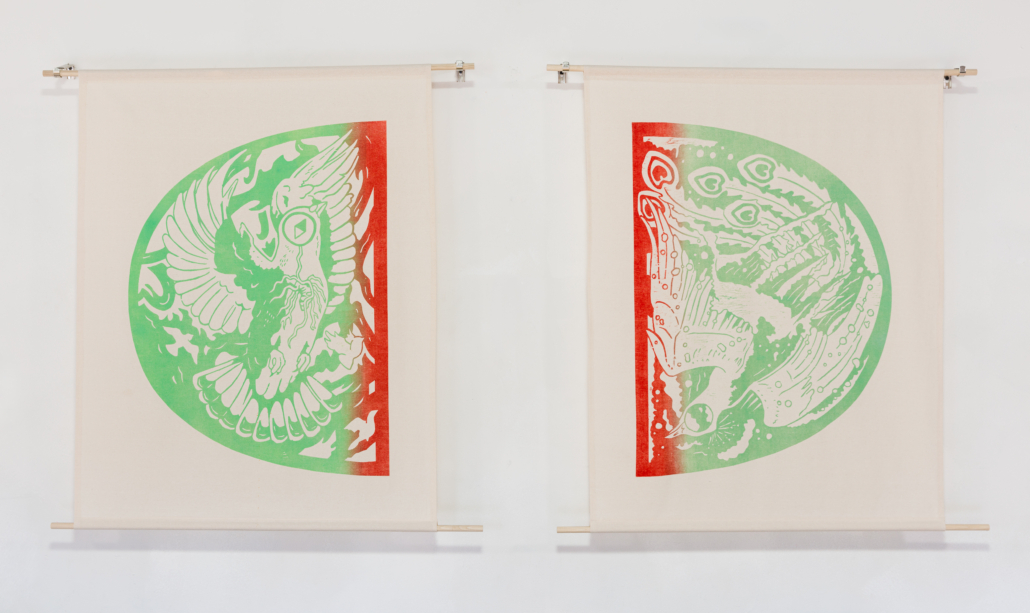
Jenie Gao
Cycle | Breaking and Making, 2023
Hand-carved woodblocks printed with fountain roll on cotton muslin canvas, 40 x 30 inches
$7,200
These works are from my series The Negotiation Table, in which I take hand-carved woodblocks and transform them into sites of negotiation. This transformation responds to the history of print, from its role as a tool of protest and community activation to its assimilation into the fine arts. I reflect on the tension of assimilation and resistance within printmaking, as a Taiwanese-Chinese American who has been made artificially rare in white dominant spaces via policies such as the Chinese Exclusion Act and (Taiwan) Magnuson Act. My woodblock prints, Cycle | Breaking and Making, resemble hand-carved jade. They depict two birds, Fènghuáng 鳳凰 and the Homing Pigeon. Fènghuáng is a mythological bird that disappears during times of political corruption and reemerges during eras of peace. The homing pigeon is a bird that I grew up raising, and a personal symbol of diaspora, class strife and finding home. Together, the birds form an endless cycle, in tension but also always in motion. I embedded the original Pigeon and Fènghuáng woodblocks in the surface of a reclaimed table, a knock-off of a popular European style called Chippendale, which is an appropriation of Ming and Tang Dynasty furniture. The popularity of this furniture was used to fuel Europeans’ obsession with Orientalism, driving them to search for a shorter route to Asia and ultimately catalyzing westward expansion and colonization of Turtle Island. In other words, from the Opium Wars to cheap Chinese labor on American railroads to the Vietnam War to Black Civil Rights, American overseas violences in Asia have always been and continue to be linked with ongoing oppression in what is called the United States. How we who live on this land move forward depends on our willingness to work towards a liberation that is local, global and collective.
Jenie Gao (they/she) runs an anti-gentrification arts business, specializing in printmaking, public art, social practice and storytelling. They consult for cultural organizations and the public sector on equity and ethics. Jenie pulls from experiences as a second-generation Taiwanese-Chinese American, queer woman of color, and a descendant of working class immigrants. Through their cross section of experiences, Jenie has become attuned to issues of artists’ labor, cultural power and institutional accountability. She runs a paid apprenticeship program and has mentored 25 emerging artists. Jenie has a BFA in Printmaking/Drawing from Washington University in St. Louis and an MFA from Emily Carr University of Art + Design. Museum exhibits include Museum of Wisconsin Art, Trout Museum of Art, Burnaby Village Museum, Cedarburg Museum, and South Bend Museum of Art. Publications include PBS, Bold Journey, Shoutout LA, and Fête Chinoise. Art residencies include City of Vancouver Parks Board; Ma’s House in the Shinnecock Reservation in Southampton, New York; Iowa Lakeside Laboratory in Okoboji, Iowa; the Bubbler at Madison Public Library in Madison, Wisconsin; Artist Campaign School in Chicago, Illinois; Proyecto’ace in Buenos Aires, Argentina; and Museo de Arte Moderno in Chile. Jenie is a TEDx Madison speaker and gave a talk entitled The Power and Purpose of Creativity.
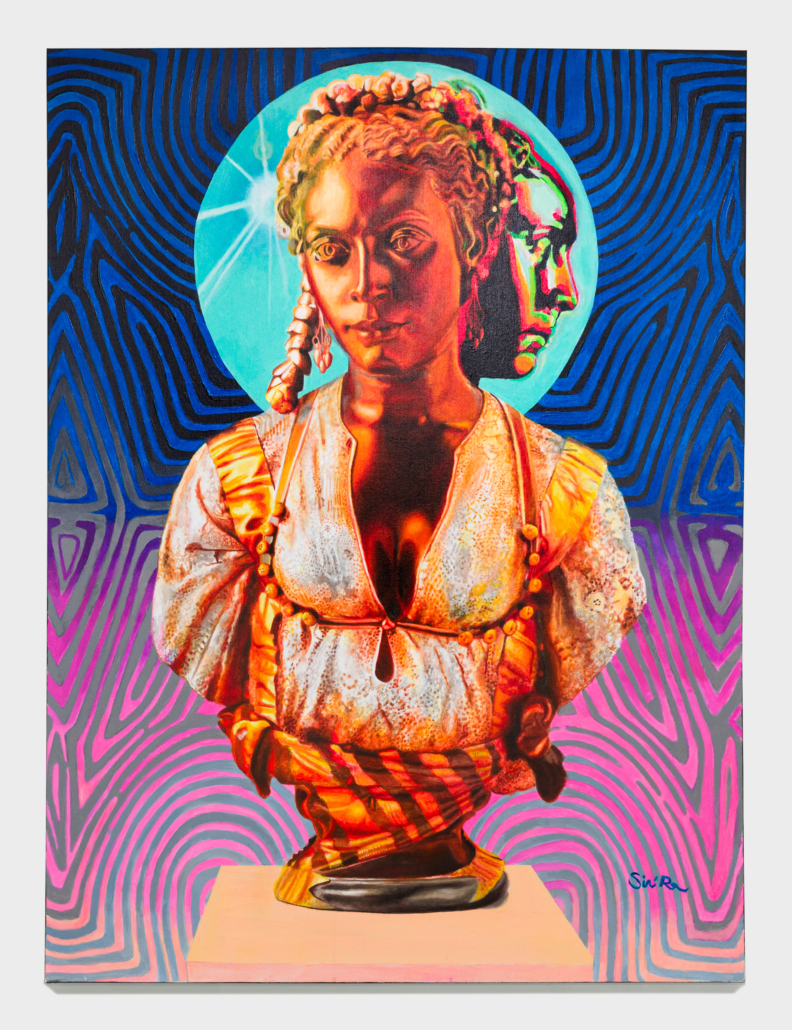
Arris’ J. Cohen (Sir’ra)
Sovereignty, 2023
Acrylic paint on canvas, 36 x 48 inches
$10,000
Sovereignty powerfully embodies the theme of State of The Nation: A BIPOC Artist Perspective by visually representing the multifaceted identity and resilience of Black women. The central figure, adorned with a halo-like aura, evokes a sense of regality and divine presence, challenging historical narratives that have marginalized Black women. The intricate detailing of her attire and the juxtaposition of traditional and contemporary elements highlight the continuity and evolution of Black women’s roles in society. This visual narrative aligns with the exhibition’s exploration of social justice by emphasizing the importance of recognizing and honoring the contributions and struggles of Black women within the broader context of political and societal change. The layered imagery and vibrant colors in Sovereignty underscore themes of intersectionality and empowerment, central to healing and transformation. The dual-faced portrayal suggests a deep introspection and the internalization of multiple identities, reflecting the complexity of navigating a world that often imposes conflicting expectations on Black women. This artistic expression speaks to the resilience and sovereignty of Black women, serving as a powerful commentary on the need for inclusive narratives that embrace the full spectrum of BIPOC experiences. By placing Black women at the forefront, the painting reinforces the exhibition’s message of acknowledging and celebrating the diverse voices that contribute to the ongoing dialogue about equity and justice in society.
Arris Cohen, known as Sir’ra, is a Cleveland born, Columbus based, classically trained visual artist who has been working professionally since the onset of the pandemic. His artistic vision is based in the diaspora and telling the story of his creative journey as an African-American. Using vibrant colors and geometric shapes with melanated peoples as his primary subject matter, his paintings reflect Afrofuturism and Afro Surrealism. His love for painting has recently expanded to large-scale murals and continues to diversify as he has been afforded the opportunity to teach and give back to communities that are more than similar to that from which he grew. He looks forward to continued growth and opportunity to inspire people to be symbols of life and positivity in a landscape where not much else can thrive, just like the Baobab Tree. His affinity for Art and giving back has transitioned into instructing high schoolers at Franklinton High School. He hopes to further that endeavor in the near future while continuing to focus primarily on his journey as a multidisciplinary artist.
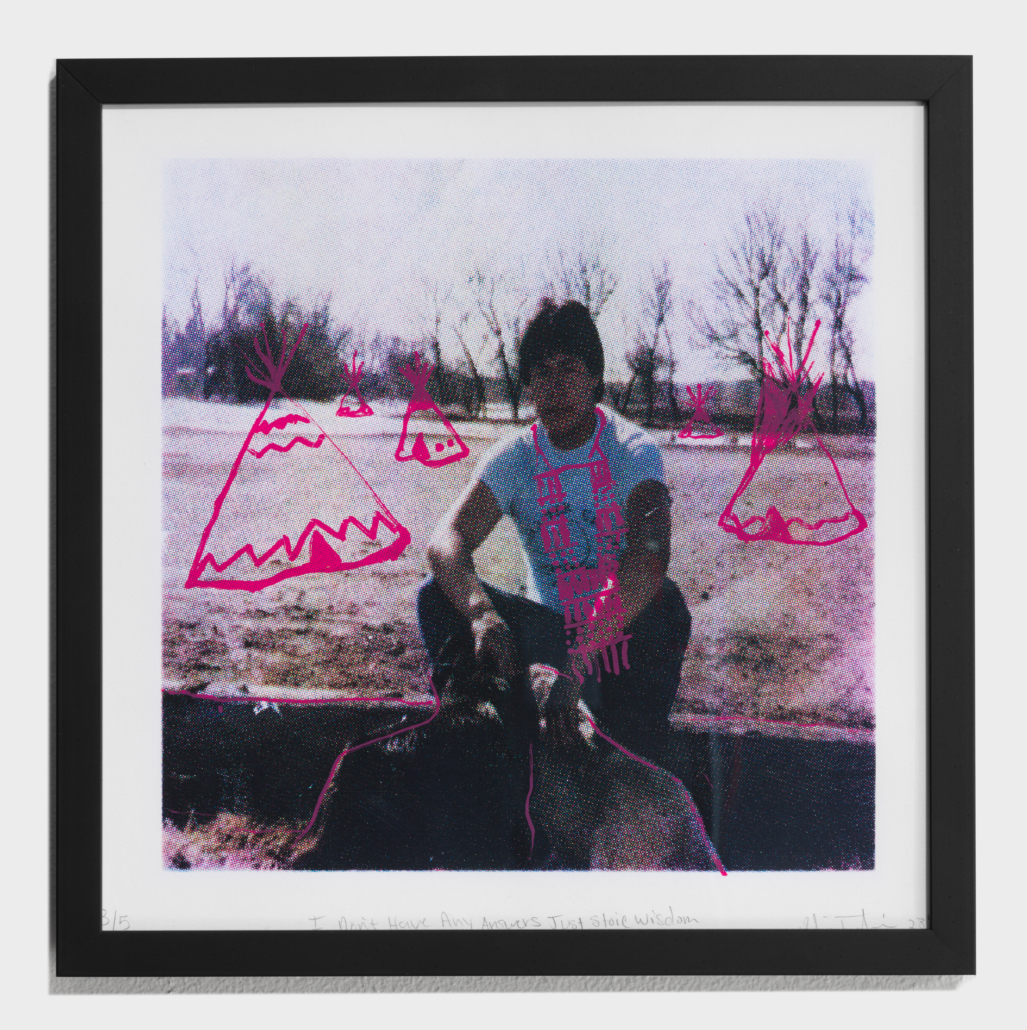
Delia Touché
I Don’t Have Any Answers Just Stoic Wisdom, 2023
Screen print, 12 x 12 inches
NFS
This is a photograph of my father on our rez, Spirit Lake Nation. Some rez dogs are accompanying him. The title of the print is a quote spoken by William “Spirit” Knifeman from the television show Reservation Dogs. For a good portion of my father’s life, he had to navigate the American incarceration system. He never had the answers on how to navigate the systems we as Native people are forced into, but he always had some kind of advice to give us. Some stoic wisdom. I thought this quote fit him well. While I was creating this print I was also contemplating that most photographs of Native folx are forced to have ethnographic baggage associated with the sitter to identify that they are Native American. Are we still Native even if a tipi isn’t in the background?
Delia Touché was born in Devils Lake, North Dakota, and is a member of the Spirit Lake Nation. They are a Sisseton Wahpeton Dakota and Assiniboine artist based in the Midwest. They have exhibited nationally and internationally. at venues such as Travemeise (Lübeck, Germany), M Contemporary Art (Ferndale, MI), Plains Art Museum (Fargo, ND), The Art Galleries at Austin Community College (Austin, TX), Cranbrook Art Museum (Bloomfield Hills, MI), BULK Space (Detroit, MI), Minnesota Center for Book Arts (Minneapolis, MN), All my Relations Gallery (Minneapolis, MN), Die Graphische (Vienna, Austria) among others. Delia has their work in permanent collections at the University of North Dakota, St. Olaf College’s Special Collections Department, Walker Art Center, Minnesota Historical Society, Northwestern University, and Bainbridge Island Museum of Art. They hold a Bachelor of Fine Arts in Drawing from Minnesota State University Moorhead and a Master of Fine Arts in Print Media from Cranbrook Academy of Art where they received the Gilbert Fellowship.
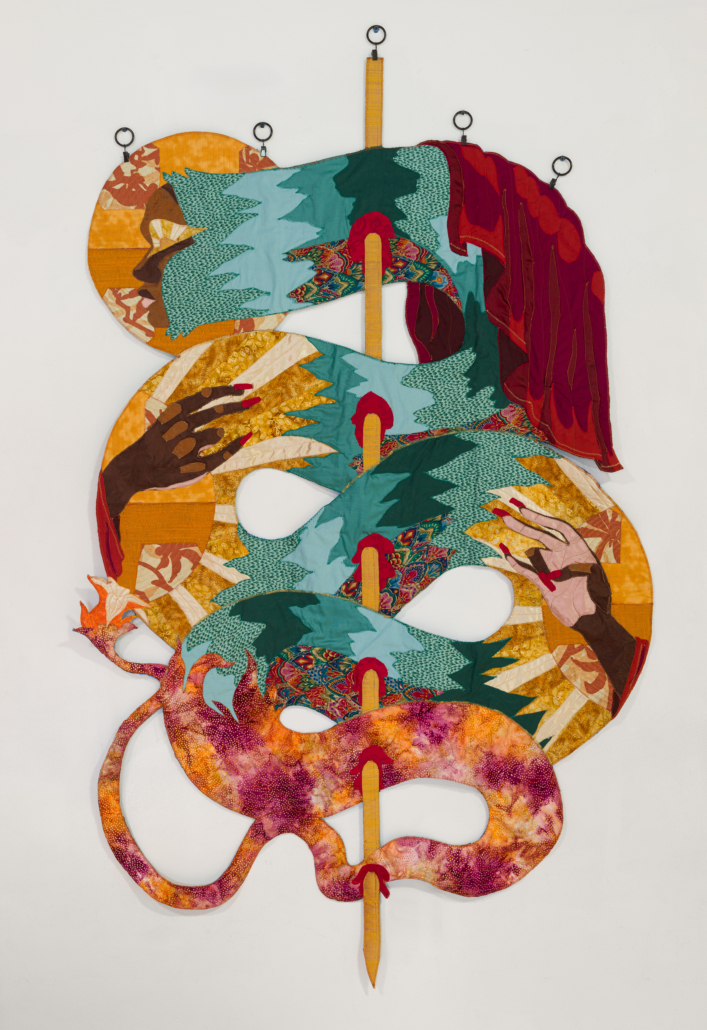
William PK Carter
Yet the Serpent Refused to Die, 2024
Assorted fabric and thread, 74 x 44 inches
$8,500
Yet the Serpent Refused to Die recontextualizes the story of the Archangel Michael slaying the serpent by equating it to the killing and violence that is enacted on Black queer people in the name of a god.
Oftentimes, in organized religion, there is a decentering of all “others” from a narrative or tale until their existence proves to be useful. Queer people of color’s existence has been used as nothing but a tool to push a righteous narrative, and because of that, our likeness has been misconstrued to be the antithesis of all morality and goodness, which is then used to justify targeted violence against us.
Our agency in our own stories has been stolen from us.
Our agency in our own lives has been stolen from us.
I refuse to let our agency get snatched from our own hands again.
The serpent was killed for its scales – for its reputation – but the name of its assailant lives on in glory. Blessed be to those who are slain in the name of any. Man heard word from above to end that which slithers, Yet the Serpent Refused to Die. William PK Carter is an interdisciplinary artist with intersectional identities, creating work that exists between mediums and social norms. They use the wonder and whimsy of fibers and puppetry to connect with other queer people of color who choose to let their imagination run wild. Working with assorted fabrics, yarn, paint, paper mache and other craft supplies that were native to their childhood school desk, they weave all aspects of their identity into their work. At its core, their art is a collection of love letters to their younger self. With every piece that they make, they allow little William to express himself authentically.
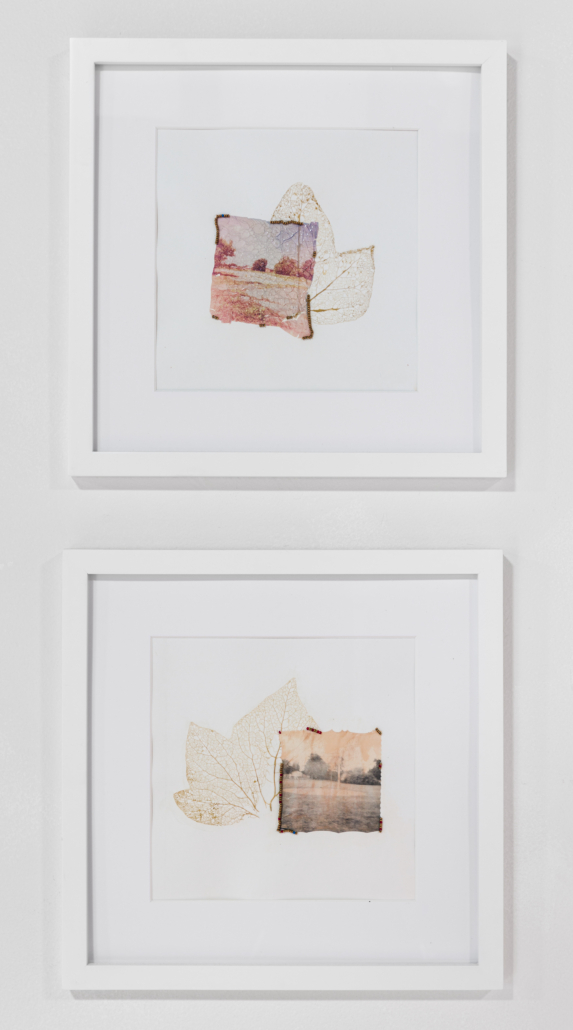
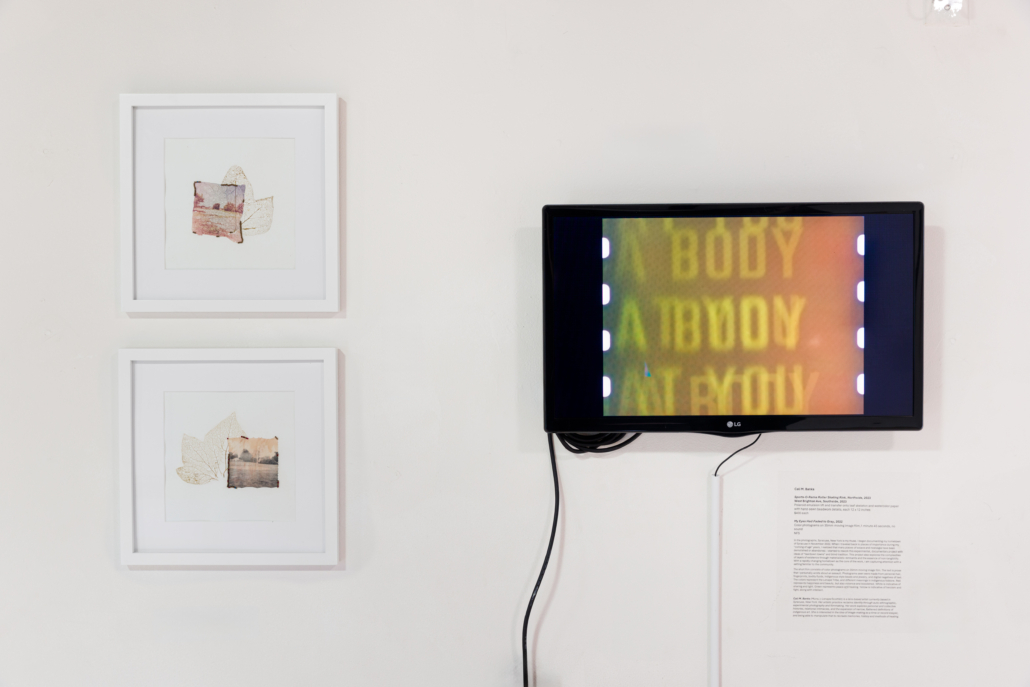
Cali M. Banks
Sports-O-Rama Roller Skating Rink, Northside, 2023
West Brighton Ave, Southside, 2023
Polaroid emulsion lift and transfer onto leaf skeleton and watercolor paper with hand-sewn beadwork details, each 12 x 12 inches
$400 each
In the photographs, Syracuse, New York is my muse. I began documenting my hometown of Syracuse in November 2022. When I traveled back to places of importance during my “coming of age” years, I realized that many places of solace and nostalgia have been demolished or abandoned. I started to rework this experimental, documentary project with ideas of “teardown towns” and blind tradition. This project also explores the complexities of layers of existence through materialistic remnants and the essence of non-tangibility. With a rapidly changing hometown as the core of the work, I am capturing attention with a setting familiar to the community.
My Eyes Had Faded to Gray, 2022
Color photograms on 35mm moving image film,1 minute 45 seconds, no sound, NFS
The short film consists of color photograms on 35mm moving image film. The text is prose that I personally wrote about an assault. Photograms seen were made from personal hair, fingerprints, bodily fluids, indigenous-style beads and jewelry, and digital negatives of text. The colors represent the Lenape Tribe, and different meanings in indigenous folklore. Red represents happiness and beauty, but also violence and bloodshed. White is indicative of sharing and light. Green represents peace and healing. Yellow is indicative of heroism and fight, along with intellect.
Cali M. Banks (Munsee Lenape/Scottish) is a lens-based artist currently based in Syracuse, New York. She holds an MFA in Interdisciplinary Media Arts Practices from the University of Colorado Boulder, and a BA in Art and Technology and Global Health Studies from Allegheny College. Cali is the Communications Coordinator for Light Work, and an Adjunct Professor of Photography, Video Art and Filmmaking for Syracuse University and Indiana University campuses. Cali is also a 2024 En Foco Photography Fellow, and serves on the Board of Directors for The Halide Project (Philadelphia, PA). Her artistic practice reclaims identity through auto-ethnographic, experimental photography and filmmaking. Her work explores personal and collective histories, relational intimacies, and the expansion of narrow, flattened definitions of indigenous art. She is interested in the idea of image-making as a time or record-keeper, and being able to manipulate that to recreate memories, history and methods of healing.
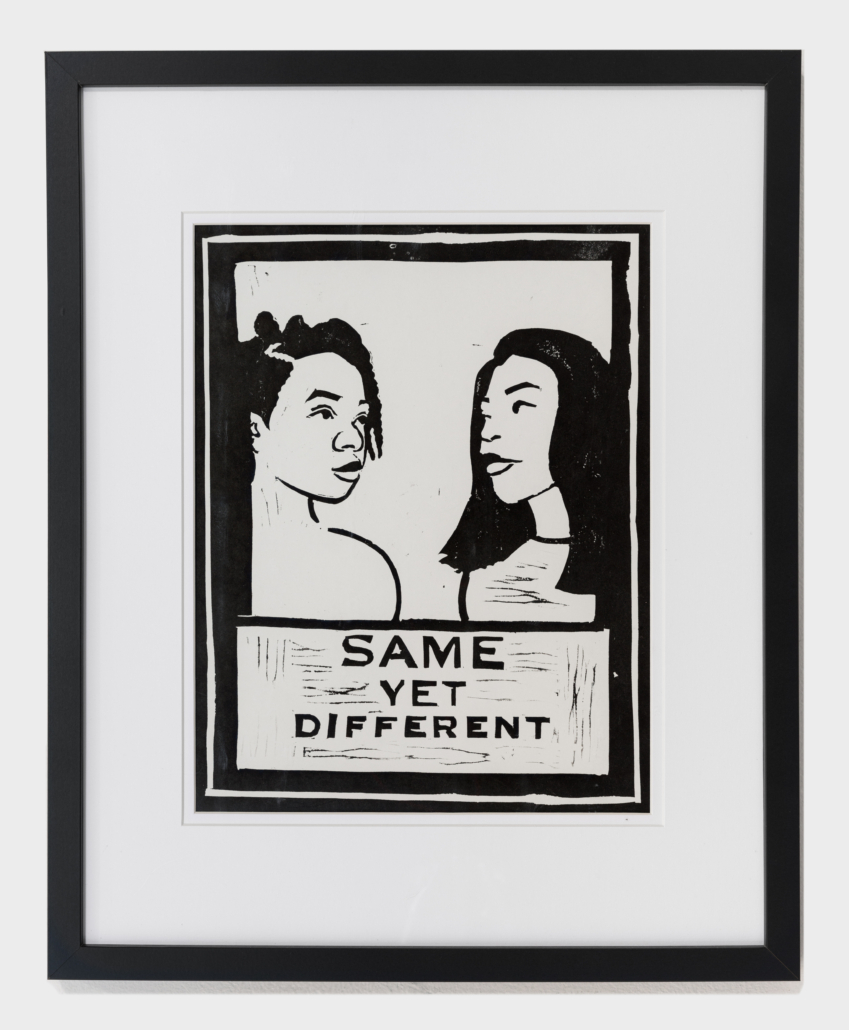
Daija Essien
The Juxtapose, 2024
Linocut relief print, 11 x 14 inches
$75
The Juxtapose aims to address the racial injustices in ethnicity within the Black community and other individuals who are from mixed backgrounds. It brings forth the idea that no matter how much you change your appearance and remain the same on the inside, you will still be seen differently externally. As the two figures gaze at each other, they represent the experiences Essien has gone through trying to feel as one living in a predominantly white population. She also alludes to the issues within her community. The idealistic notion that minorities need uplifting contrasts starkly with the daily reality she experienced.
Daija Essien, a multidisciplinary artist from Louisiana, creates work centered on decolonizing her mindset, questioning her sense of belonging, and uncovering her heritage as a second-generation immigrant. Her art delves into the complexities of navigating multiple social spaces in the South, which often left her feeling out of place and led to subconscious code-switching as a coping mechanism. By employing textiles, various printing methods, and painting, Essien presents the figure to convey the struggle and frustration of reestablishing identity within the African diaspora and society’s obsession with labels.
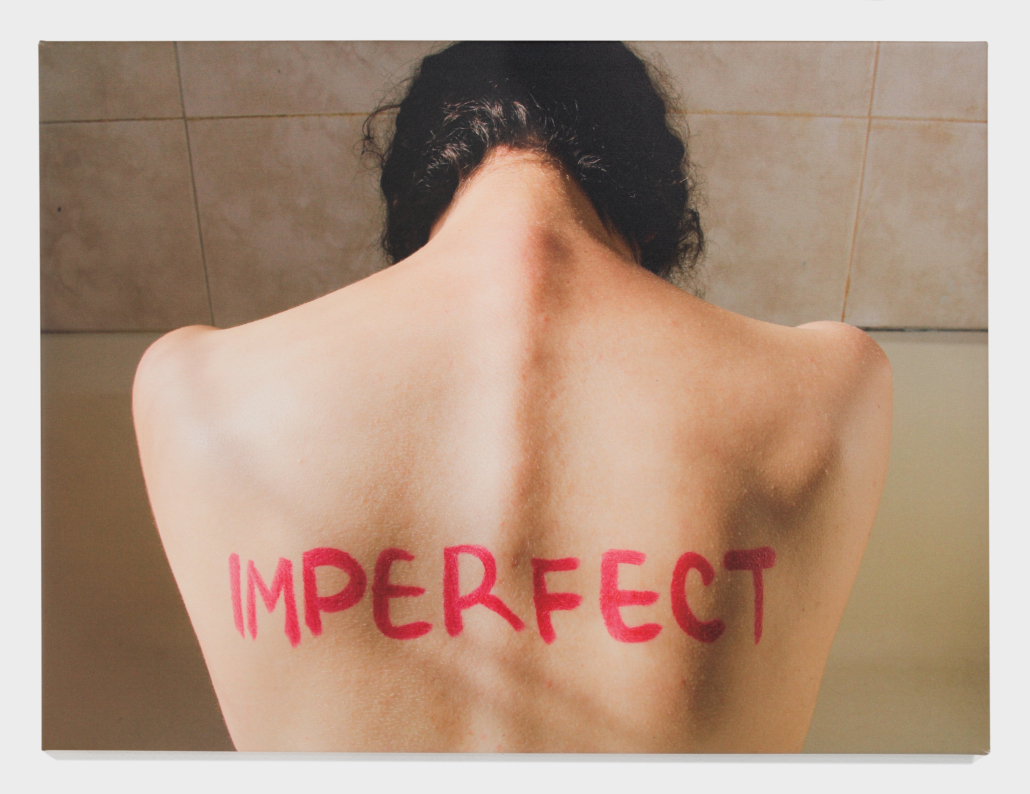
Christine Stoddard
Imperfect, 2023
Digital photography on canvas, 48 x 36 inches
$300
Imperfect is from Regaining, a series on isolation, reclamation and healing related to racialized and feminized bodies in connection to various types of toxic relationships, whether personal or historical. All images are natural light self-portraits of the artist or details from staged scenes related to self-portraits. Narrative in nature, Regaining is a series of diaristic, parafictional photographs, with an emphasis on natural lighting, femme aesthetics, handwritten text and plant and animal matter.
Christine Stoddard is a Salvadoran-American writer, artist, and performer named one of Brooklyn Magazine’s Top 50 Most Fascinating People. A Ms. Magazine “Ms. Muse” and Miss Subways Finalist, she founded Quail Bell Press & Productions, including Quail Bell Magazine. Her most recent solo exhibition was at the Queens Botanical Garden in Flushing. Her visual art and films have been shown widely. at Jamaica Center for Art & Learning, the Poe Museum, Pratt Institute, Cinema Village, the Latino Film Market, the Belskie Museum, the New York Transit Museum, Manhattan Neighborhood Network, and beyond. Her work has been supported by Arts By the People, the Foundation for Contemporary Arts, Chashama, Support Creativity, the Puffin Foundation, ArtBridge, IndieSpace, the Hudson Valley Writers Center, Arts Gowanus, and other fine organizations. A current MS Documentary Film candidate at Columbia University, she earned her MFA in Interdisciplinary Art from The City College of New York. As of 2024, she is the curator-in-residence at AnkhLave Arts Alliance on Governors Island. YouTube/IG/FB/TikTok @StoddardSays; WorldOfChristineStoddard.com
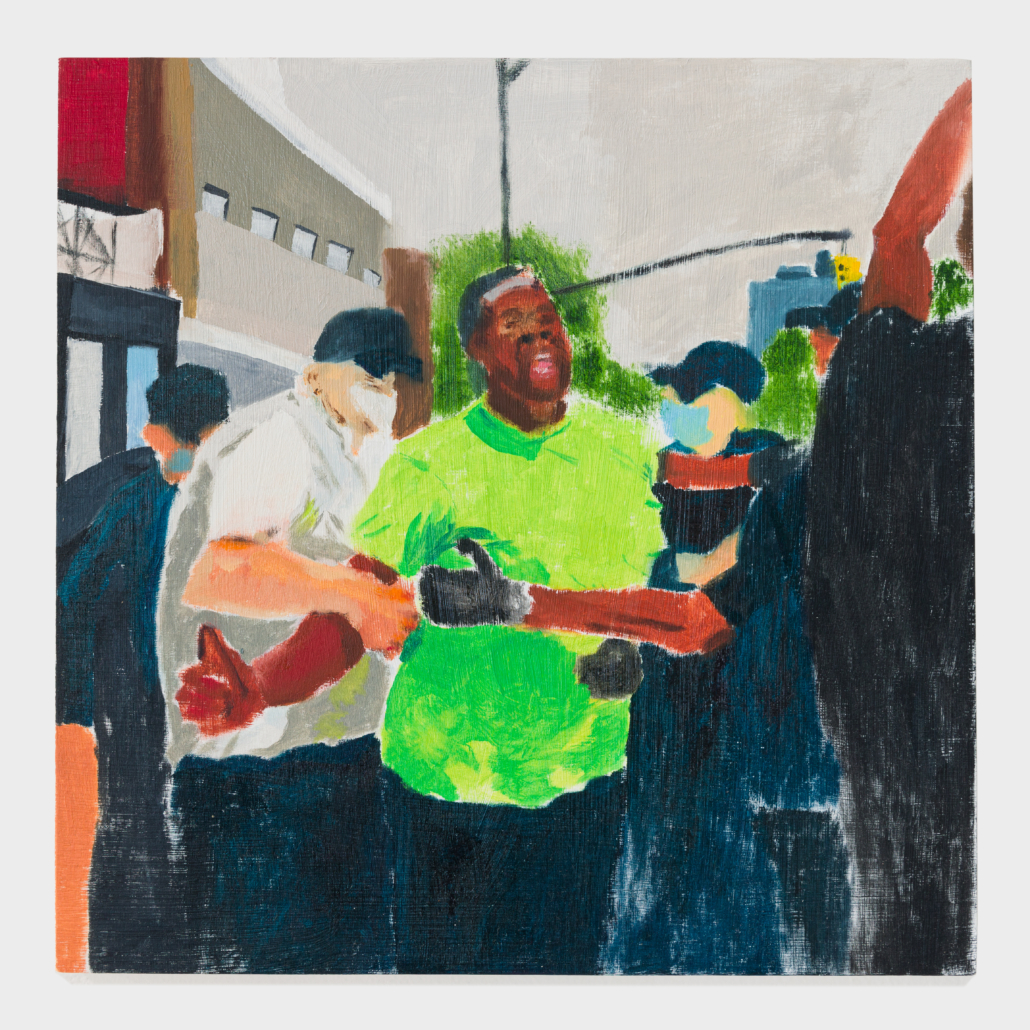
Zakariya Abdul-Qadir
D-NY 20 Senator Zellnor Y. Myrie (Living Legend), 2022
Oil on wood panel, 12 x 12 inches
$350
In the summer of the 2020 COVID-19 pandemic, our streets erupted in public outcry following the murders of Breonna Taylor and George Floyd. During a protest at the Barclays Center, Senator Zellnor Myrie was pepper sprayed. This was an indicator of the temperature of the country. At this moment there is a similar inflection point, globally and nationally; with the ongoing Russo-Ukrainian and Israeli-Palestinian wars and our political climate this election year, we are experiencing heightened tensions. This work was produced under similar conditions.
D-NY 20 Senator Zellnor Y. Myrie (Living Legend) is part of an ongoing body of work called the Living Legend series. This series consists of portraits of local politicians and civic leaders who are actively changing systems within their communities and advocating for their constituents. I began this project asking myself, “What are the implications of a government not built to represent its people?” This question is ever-pressing as we approach another fraught election season.
Zakariya Abdul-Qadir is a New York-based artist. He uses his practice as a chronicling of the day-to-day. Abdul-Qadir began his career after graduating from Brooklyn College and working within the service industry affording him time to pursue his practice. He later began to articulate his visual vocabulary looking at the spaces between colors and their meeting point. The dialogue of the colors informs each layer of paint one after the next like an improvisational jazz lick, creating an impression of spontaneity while reserving a feeling of the quotidian. He is currently seeking an MFA at Pratt Institute and is anticipated to graduate in Spring 2025.
This exhibition is made possible, in part, by the New York City Department of Cultural Affairs and the New York State Council on the Arts with the support of the Office of the Governor and the New York State Legislature.



